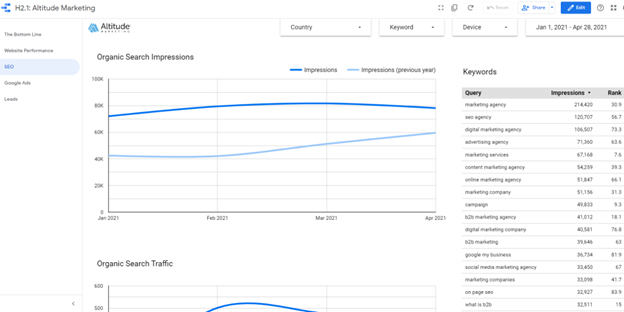A Step-By-Step Approach To Creating A Predictable Revenue Model (PRM) For Your Business
By Louis Holzman, Director of Business Development, Altitude Marketing

The digital age has completely changed the game in business, data, and the world. Information, knowledge, and data are now so accessible, the biggest challenge is no longer finding it, but keeping data organized and ensuring the knowledge is credible and information is sound.
Here’s why it matters and how it is put into play. The internet is now used for purchasing no matter what industry or vertical, eCommerce or not, B2B or B2C- selling things online is not going away.
Fifteen to twenty years ago, the innovation of communication online via email and chat or maybe even to view a company’s website or digital brochure was progressive. Fast forward to today, we are one-click shopping for any and every household item you could think of, having our new cars drop-shipped, and educating oneself about a service or solution through educational material online when purchasing a software or high-ticket operational asset for your business is expected.
With every business, consumer, man, woman, and child plugged into the internet, it would be a misstep to not capitalize on the data. We can hone-in on our target's buying cycle and process to build a digital sales funnel specifically for them. Ultimately, raising visibility, instilling credibility, educating the audience, and driving new business revenue.
Without the proper foundation in place, paralysis by analysis of the data may take effect and no true action steps forward can be taken. The following provides detail to all 8 steps in creating a Predictable Revenue Model.
Here are the eight steps you can employ to develop a PRM for your business followed by a more detailed explanation of each.
- Build a reporting dashboard that houses marketing and sales data
- Develop an inbound marketing strategy and start executing
- Codify an outbound sales and account-based marketing program that works for your team and targets
- Build parts of the inbound funnel to support the outbound/ABM activities
- Ensure an open and consistent feedback loop between the sales and marketing teams
- Test, measure and refine effectiveness at each stage of the funnel- Cold lead, MQL, SQL, Closed Won/Lost
- Do more of what’s driving results to better predict future outcomes.
And REPEAT!
Selecting the Right Marketing Technology Stack
Marketing automation software can do amazing things. It makes it significantly easier to reach prospects, to engage them in a meaningful way and to generate actionable insights from those engagements.
Savvy marketers need a lot of technology. At a minimum, you’re going to require:
- a website CMS
- SEO guidance
- an email platform
- premium images and photos
- web analytics
- website performance testing
- data visualization
- plug-and-play integrations
- screen capture software
- a writing assistant
- a marketing calenda
- social media scheduling
Building a Reporting Dashboard for Marketing and Sales Data
My experience with Altitude Marketing has been through Goggle Data Studio. The report is updated 24/7/365 through APIs and Zapier “Zapa” which allows real-time data analysis and empowers users to always be in the know. Here is a sample report from an actual screenshot.

Develop an Integrated Marketing Strategy and Start Executing
A sustainable, measurable marketing strategy is the cornerstone of success in today’s fast-changing, increasingly crowded marketplace. It’s tempting to jump right to tactics because it feels good to “do something” to promote your business, but if your marketing efforts aren’t working together, they’re working against you.
If you’re not generating business or even lead, your marketing strategy isn’t working!
Codify an Outbound Sales and Account-Based Marketing (ABM) Program
Account-based marketing (ABM) has gained incredible traction in B2B marketing and for good reason. B2B ABM is delivering significant increases in ROI and deal size.
Too many sellers fail at content dissemination. It’s too hard, too disorganized, or just doesn’t show results. Nurturing sales prospects with targeted content in the only way to warm-up a completely cold lead, especially when reaching out outbound.
Building the Inbound Funnel to Support the Outbound/ABM Activities
Running inbound and outbound campaigns simultaneously with a synonymous message brings an all-encompassing funnel to your outreach. For example, if you are targeting manufacturers in a specific geographic area for outbound/ABM, one of the inbound campaigns running simultaneously should be targeted towards manufacturers in the region. This gives outbound efforts something else to stand on and push their cold prospect in to help warm them up and give education and credibility.
This also helps fill the inbound funnel. Maybe the outbound prospect isn't ready to take a consultation call or discuss their pain points with you yet. But if you have compelling content, and a solid inbound funnel that retargets that outbound prospect to a landing page, pushes them to a premium content piece and further helps their own educational journey, two likely scenarios appear. One, they reach out on their own within the inbound funnel, great success. Two, the outbound salesperson (should be) continuing to follow up and will now have the opportunity and willingness from the prospect to get on the phone.
Ensure an Open & Consistent Feedback Loop Between Sales & Marketing
Sadly, there are still companies in which marketing throws something over the wall to sales and hopes someone is there to catch it. Your marketing team needs to be working hand in hand with the sales team. These two departments are no longer segregated as the gray line between sales and marketing is blurred. Marketing needs to communicate with sales the appropriate messaging, positioning and strategy to tackle inbound and outbound efforts.
Sales needs to ensure they circle back to marketing with what is working and what isn’t working as they field inbound leads or are out in the field hunting outbound/ABM. Each of these data points needs to be tracked and analyzed by some sort of sales/marketing intelligence. This should be able to be done through the dashboard built in Step 2.
Test, Measure and Refine
It is important to test, measure, and refine effectiveness-are you hitting your outcomes-at each stage of the funnel. Use the data both marketing and sales generate to be smart about where you and your team spend their time, resources, and dollars.
Do more of what's working, kill what's not. It may be a challenge wrangling those lone shark salespeople who only do it their way. But if you can prove to them with the data how this approach will drive them more business, ultimately more money in their pocket, they will listen.
Do More of What’s Driving Results
Doing more of what’s driving results will help better predict future outcomes. Wash, rinse and repeat. Pull your sales and marketing teams' in close and ensure they are in lockstep together.
Conclusion
Predictable Revenue Models are here, and they are here to stay. They are not easy to build, and it is not just a once and done setup. It's working closely interdepartmentally and understanding that at first, it's all going to look like a big spider web of random data points.
The more you understand your buyer, the easier it is to reverse engineer the funnel they go through during their buying process. The easier it is to understand the data they kick out while they are educating themselves, the quicker you can serve up content and a clear message to them that will resonate.
If you bring a holistic practice to sales, marketing, inbound, outbound and technology you will win the forecasting battle in understanding how you will generate your next net new business.
If you are curious to learn more about anything mentioned in the 8 step process to create a PRM, please visit the Altitude blog page.
About the Author
 Louis stands between new business for Altitude by determining the right fit for both the agency’s internal team and processes as well as prospective clients’ needs and goals.
Louis stands between new business for Altitude by determining the right fit for both the agency’s internal team and processes as well as prospective clients’ needs and goals.
Each prospect is looking for a marketing agency that can help them meet their unique business challenges, and Louis is dedicated to assessing not only what they’re asking for, but what they need – and whether Altitude is the right tool for the job. Louis understands that “fit” is important for both Altitude and our clients as long-term mutually beneficial relationships are what drives success for clients and ultimately the growth of Altitude. He seeks out potential clients while continually developing partnerships and serves as a part-time account manager for select projects and time block accounts.
Louis has a bachelor’s degree in athletic training from West Chester University and has always found himself building teams, businesses, and communities. He is a founding member and VP of the Allentown Young Professionals, vice-chair of the Allentown Arts Commission, and volunteers for Big Brother Big Sisters of the Lehigh Valley and the Mandela Washington Fellowship. He loves playing the drum set with his band The Front End, shooting hoops, writing for local publications, and house hunting.
About Altitude Marketing
Altitude is a full-service, B2B integrated marketing and communications agency that puts your company on the map. Our proven methodology ensures that we get smart quickly about highly complex concepts, so we can translate them into meaningful market positioning, compelling brand messaging and lead-driving strategies. The result is a fresh approach that distinguishes your brand in a marketplace that’s cluttered with hard-to-differentiate businesses.
Altitude provides clients with a full suite of integrated digital and traditional marketing services. With Altitude, all of your efforts work together, multiplying results and delivering swift, measurable ROI. Visit the Altitude website.
